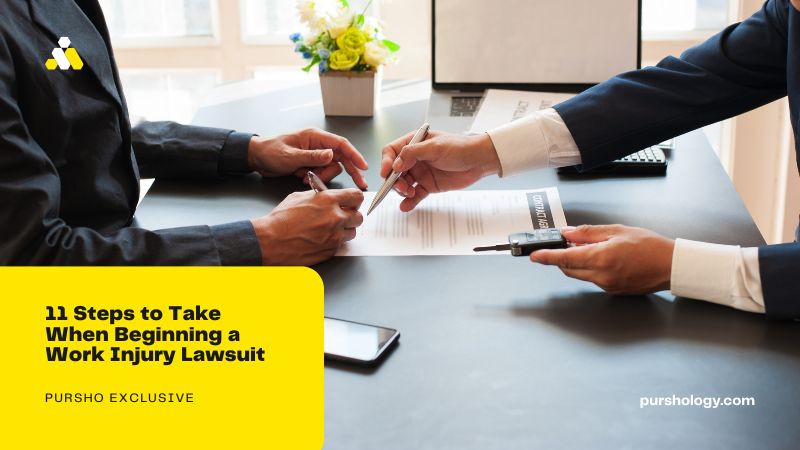Workplace injuries can be a jarring experience, turning a regular day at work into a long-term struggle for justice and compensation. In Texas, pursuing a work injury lawsuit requires careful navigation of the legal landscape, which calls for the advice and guidance of qualified product liability lawyers. Knowing the right steps to take can greatly enhance your chances of receiving the compensation you deserve.
11 Steps to Take When Beginning a Work Injury Lawsuit in Texas
1. Get Well-Acquainted with the Texas Workers’ Compensation System
Texas stands out from most other states in that employers aren’t mandated to participate in the workers’ compensation system. However, if they opt out, they forfeit certain legal defenses if an injured worker decides to sue. If your employer has workers’ compensation insurance, you typically cannot sue them for personal injury damages, unless the injury was a result of gross negligence leading to a fatality.
2. Seek Medical Attention
Immediately after an injury, seeking medical attention is paramount. The next crucial step is reporting the injury to your employer. In Texas, you have 30 days to inform your employer of the injury. Failing to do so might jeopardize your chances of obtaining compensation.
3. Select Knowledgeable Product Liability Lawyers
Having a skilled attorney who is well-versed in Texas work injury laws is invaluable. They can guide you on whether you should pursue a claim through workers’ compensation (if available) or proceed with a personal injury lawsuit.
4. Gather Evidence
A strong case is built on concrete evidence. This can include photographs of the injury site, witness statements, and medical reports detailing the extent of the injury. The more detailed and comprehensive your evidence, the stronger your case will be.
5. File the Lawsuit
If your employer lacks workers’ compensation insurance, or if there’s a third party responsible for your injury (like a machinery manufacturer), you might opt to file a personal injury lawsuit. Your attorney will draft and file a complaint, indicating the basis for the lawsuit, the parties involved, and the compensation sought.
6. Consider Your Options
Mediation
Before heading to trial, parties often consider mediation to reach a settlement. A neutral mediator will work with both sides, attempting to find common ground. If a satisfactory agreement is achieved, the case concludes without a court trial.
Arbitration
Unlike mediation, which is non-binding and serves as a facilitated negotiation, arbitration involves presenting your case to a neutral third party, called an arbitrator. This individual then makes a decision which, depending on the agreement prior to arbitration, might be binding for both parties. For those hoping to avoid the prolonged process and public nature of a court trial, arbitration can be a preferable route.
7. Consider Possible Non-Subscriber Claims
In Texas, a non-subscriber is an employer who opts out of the state’s workers’ compensation system. If injured while working for a non-subscriber, you may have the right to sue your employer for negligence. To succeed, you must demonstrate that the employer’s negligence contributed to the injury. However, non-subscribers can use certain defenses, such as arguing that the worker’s own carelessness was the sole cause of the injury. This nuance can significantly impact the trajectory of your case.
8. Find an Expert Testimony
Expert testimony can significantly bolster a work injury lawsuit. Medical professionals can provide insights into the nature and projected longevity of injuries, while workplace safety experts can highlight areas where an employer might have fallen short of industry standards. In cases where the injury’s cause is disputed or complex, such testimony can be a pivotal factor in swaying the outcome. A qualified lawyer can connect you with experienced medical experts who can help your case.
9. Consider all Potential Damages
Medical Expenses
This covers current and future medical bills related to the injury.
Lost Wages
This is compensation for wages lost while recovering from the injury.
Loss of Earning Capacity
If the injury affects your ability to earn in the future, you can seek damages to compensate for those estimated projected losses.
Mental Anguish
This refers to the emotional trauma and stress related to the injury.
10. Consider Potential Challenges
Every lawsuit comes with its challenges. In Texas, if an employer can prove you were intoxicated at the time of the accident, they might be exempted from liability. Similarly, if a worker was aware of a risk and voluntarily engaged in a dangerous activity, the employer could be protected under the “assumption of risk” defense. It is important to be aware of these potential roadblocks and to find out more from legal experts as you build a robust case.
11. Understand the Statute of Limitations
In Texas, the statute of limitations for personal injury claims, including work injuries, is typically two years from the date of the injury. While there are some exceptions, it’s pivotal to initiate the lawsuit within this period. Otherwise, you risk the court dismissing your case.
Embarking on a work injury lawsuit in Texas demands a clear understanding of the state’s unique legal terrain. Though the process can seem daunting, with the right steps and expert guidance, you can navigate this journey to achieve a fair outcome. If you or someone you know is considering such a lawsuit, ensure you’re armed with knowledge and the right legal counsel for high-quality product liability lawyers to make informed decisions every step of the way.




